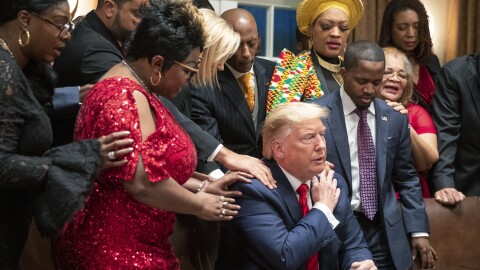In 2016, Black voters in Ohio were among those most targeted for digital-media misinformation. Often, the goal wasn’t so much to sway their votes as to ensure they wouldn’t vote at all.
Ohio voting advocates are concerned the same type of campaign is in play this year – but many are going on offense instead.
One of the most high-profile campaigns is “,” spearheaded by LeBron James and other athletes this summer.
“We need you to join us to vote like our lives depend on it," James underscores in a video encouraging people to vote, "because they do.” Another video recruits young people to be poll workers, while another talks about legacy.
But such efforts are running up against powerful counter-messaging: that Black votes don’t matter because neither Democrats nor Republicans really care.
Curtis Maples, a member of the board of the , says that counter-messaging works because it’s layered onto a reality that Black interests often have been discounted by people in power.
“You can use the logical fallacy of suggesting, well, since racism is still here and you’ve been voting Democrat all this long time, therefore the Democrats have done nothing for you," says Maples, who is Black. "In reality, it’s far more complicated than that. But it’s enough for a tweet or a meme."
Maples has spent a lot of time studying the tools used for more than a century to keep African Americans from voting. Many are neither new nor subtle: poll taxes, literacy laws, voting prohibitions against former felons, laws to scale back the early, in-person voting that Black voters embrace.
But Maples said social media has offered a suppression tool that is personal, massive and extra-ordinarily hard to track.
“With the advent of technology and social media, lies travel faster than the truth,” Maples says.
Young Mie Kim, who specializes in the study of digital media and politics at the University of Wisconsin, notes that lies rarely sway a voter to support another candidate. But they’re great at sowing confusion and apathy with messages “targeting African Americans, like ‘Neither candidate serves African-American communities, so your vote is not going to count anyway.’”
She said Russian intelligence was an early adopter of the tactic, but it isn’t alone. And last month, the British public television station Channel 4 how deep a root it took in 2016.
“What we found is that in those crucial swing states, Black voters were disproportionately marked for deterrence,” Channel 4 reported.
It found the Trump campaign used a massive database to target 3.5 million African American voters in Ohio and other swing states to get them to sit out the 2016 election. The social media messages micro-targeted everything from a voter’s personality type to their income to whether they owned a dog.
That election, Black voter turnout dropped for the first time in 20 years.
But this year, Democrats are not ceding one of their most loyal voting blocs. The Democratic National Committee has upped digital advertising and ad buys on Black radio stations and newspapers in Ohio, headlined with the message, “Our lives are on the ballot.”
Maples said Democrats must recognize why the discouraging messages of 2016 resonated, by openly acknowledging racism is reality.
“We are keenly aware that ‘colorblind’ or neutral policies when you have an unequal society is a tacit admission that you want things to stay exactly the same,” he said.
But Maples also advocates a change in tactics. Many get-out-the-Black-vote efforts rely on pride in the accomplishments of the Civil Rights movement, but studies show shame may be more powerful, especially among those who rarely vote.
“They sent out postcards that threatened to say, 'This is your voter record (because your voter record is public), and we’ll let all your neighbors know if you didn’t vote.' That increased voter turnout by 28%,” Maples says.
Advocates are also exploring how to tap into the energy of the summer’s racial justice protests.
Raymond Greene of , which focuses on civic engagement in Black communities in Ohio, said campaigns should borrow from what galvanized and mobilized the protests instead of only offering tried—but often tired—opportunities like phone banks.
"During a protest, you’ve got creative artists; you’ve got the spoken word; you’ve got music being created along with the protests. You get to see regular people become influencers,” Greene said. “And what we’re saying is actually, that should be in our electoral work also.”
But, perhaps counter-intuitively, protesting and voting don’t automatically go hand-in-hand. Some of those who took to the streets this summer see it as the path to needed revolutionary change, whereas voting is the status quo.
Ohio voting advocates say the challenge is convincing Black voters there is power in both.





